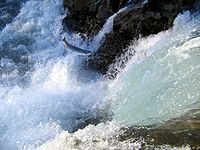
Photo from wikipedia
Life history variation is fundamental to the evolution of Pacific salmon and their persistence under variable conditions. We discovered that Chinook salmon sort themselves into surface- and bottom-oriented groups in… Click to show full abstract
Life history variation is fundamental to the evolution of Pacific salmon and their persistence under variable conditions. We discovered that Chinook salmon sort themselves into surface- and bottom-oriented groups in tanks within days after exogenous feeding. We hypothesised that this behaviour is correlated with subsequent differences in body morphology and growth (as measured by final length and mass) observed later in life. We found consistent morphological differences between surface and bottom phenotypes. Furthermore, we found that surface and bottom orientation within each group is maintained for at least one year after the phenotypes were separated. These surface and bottom phenotypes are expressed across genetic stocks, brood years, and laboratories and we show that the proportion of surface- and bottom-oriented offspring also differed among families. Importantly, feed delivery location did not affect morphology or growth, and the surface fish were longer than bottom fish at the end of the rearing experiment. The body shape of the former correlates with wild individuals that rear in mainstem habitats and migrate in the fall as subyearlings and the latter resemble those that remain in the upper tributaries and migrate as yearling spring migrants. Our findings suggest that early self-sorting behaviour may have a genetic basis and be correlated with other phenotypic traits that are important indicators for juvenile migration timing.
Journal Title: Environmental Biology of Fishes
Year Published: 2017
Link to full text (if available)
Share on Social Media: Sign Up to like & get
recommendations!